Hummingbirds are amazing creatures. They’re tiny, they fly backward, and they can hover in mid-air. They’re also really good at pollinating flowers. Hummingbirds are so good at pollinating that some scientists think they may be even better than bees!
So, do hummingbirds pollinate? The answer is a resounding YES! Hummingbirds are excellent pollinators and play a vital role in the ecosystem.
Pollination Basics
Before we get into how hummingbirds pollinate, let’s quickly review what the pollination process is. Pollination transfers the sticky pollen grains from the male organ (stamen) of a flower to the female organ (pistil).
Pollen is a powdery substance that contains the male reproductive cells of a plant. The pistil is the female reproductive organ of a plant. When the pollen from the stamen enters the pistil, it fertilizes the plant’s egg cells. Successful pollination plays an essential role in plant reproduction.
Cross-pollination occurs when a pollinator visits various flowers, spreading pollen.
Cross-pollination is important because it helps to keep plant populations diverse. If all the pollen came from one plant, then all the plants would be genetically identical. But with cross-pollination, each plant has a unique combination of genes.
This genetic diversity is essential for the survival of plant species. It helps plants to adapt and evolve, so they can better survive in changing environments.
Hummingbirds: Pollination Machines
Hummingbirds are some of the best pollinators out there. They have long beaks that allow them to reach deep into thousands of flowers to get to the nectar. While they’re inside the flower, their feathers and bodies collect pollen. The hummingbird then transfers the plant pollen to the next flower it visits. Since they feed five to eight times per hour, they visit hundreds of flowers in a day.
Hummingbirds have some incredible adaptations which make them excellent pollinators.
- Hummingbird bills are long and slender, and allow them to reach into deep blooms.
- They also have slender, extendable tongues that can lap up nectar from flowers. In fact, they can lick 10–15 times per second!
- Their feathers are covered in tiny hooks that help to collect pollen and spread it from flower to flower.
- Their rapid wing beats also create a lot of turbulence. This turbulence helps to spread pollen from one flower to the next.
- They can hover in mid-air, which allows them to reach a wider range of flowers.
Hummingbirds visit hundreds of flowers each day, and they often travel long distances in search of food. A hungry hummingbird can pollinate many different plants over a large area, giving them a crucial role in floral reproduction.
Do Hummingbirds Pollinate Fruit Trees?
One of the most common questions people ask about hummingbirds is whether or not they pollinate fruit trees. The answer is yes; hummingbirds do pollinate fruit trees! In fact, hummingbirds play a vital role in the pollination of many different species of plant life.
- Fruit Trees: Hummingbirds pollinate many different types of fruit trees, including mangoes, bananas, and avocados.
- Flowering Plants: Hummingbirds are important pollinators of many flowering plants, such as lilies, roses, and hibiscus.
- Tropical Trees: Many tropical trees rely on hummingbirds for pollination assistance, including balsa, mahogany, and teak.
Are Hummingbirds Better Pollinators Than Bees?
Hummingbirds are particularly efficient pollinators because they have a habit of visiting the same type of flower over and over again. This means that they’re more likely to transfer pollen between their favorite plants of the same species.
Bees, on the other hand, often visit many different types of flower blossoms. This means that they’re less likely to transfer pollen between plants of the same species.
There are some bonus advantages to a plant being pollinated by hummingbirds over insects, and some historically insect-pollinated flowering plant families have used evolution to make the switch to hummingbird visitors.
What Kind of Flowers Do Hummingbirds Pollinate?
They are particularly good at pollinating certain types of flowers, such as trumpet-shaped flowers. This is because they have long beaks that can reach into the depths of the flower to collect nectar. Many flowers have adapted to attract and facilitate hummingbirds.
- Color: Many flowers that are pollinated by hummingbirds have adopted bright colors. This is because hummingbirds are attracted to colorful flowers.
- Nectar: Hummingbirds feed on nectar, so many flowers have adapted to produce a reservoir of nectar. This flower nectar is a natural food source for hummingbirds, and it also attracts them to the flower.
- Shape: Many flowers that are pollinated by hummingbirds have long, trumpet-shaped petals. This tubular bloom shape allows hummingbirds to reach the nectar deep inside the flower.
- Positioning: Many flowers that are pollinated by hummingbird species are positioned in such a way that the hummingbird won’t brush against leaves and stems.
- Pollen: The most popular hummingbird flowers have far more pollen than insect-pollinated blooms. This is due to the fact that they visit the flowers significantly less frequently than other pollinators.
Are Hummingbirds Good For Your Garden?

Yes, hummingbirds are good for your garden! Not only do they pollinate plants, but they also help to control pests. Hummingbirds eat a lot of insects, including:
- Aphids
- Mosquitoes
- Moths
- Beetles
- Wasps
- Spiders
This makes them a valuable asset to any garden.
Protecting Hummingbirds
Despite the many benefits that hummingbirds provide, they are still at risk of becoming extinct. There are a number of things that you can do to help protect these important animals.
Plant a Hummingbird-Friendly Garden
The best way to attract hummingbirds to your garden is to plant hummingbird-friendly plants and native flowers that they like. This will provide them with an excellent food source and a place to nest. Some of the best flowers for attracting hummingbirds include:
- Honeysuckle
- Trumpet Creeper
- Red Columbine
- Hummingbird Sage
- Bee Balm
You should also avoid using pesticides and herbicides in your hummingbird garden. These chemicals can be harmful to hummingbirds. Also, never underestimate the power of a nectar feeder in attracting hummingbirds. A hummingbird feeder full of sugar water can be a veritable hummingbird magnet!
Reduce Your Carbon Footprint
One of the biggest threats to hummingbirds is climate change. As weather patterns change, the habitats that hummingbirds rely on are also changing. This can lead to the extinction of some species of hummingbird.
You can help to reduce the effects of climate change by reducing your carbon footprint. There are a lot of basic ways you can reduce your impact on the world around you without making huge sacrifices.
Put Your Birdwatching to Scientific Use
There are multiple citizen scientist programs you can join in order to contribute to hummingbird research and protection.
For example, Audubon has a program where you can submit your bird sightings, which are then recorded and used by scientists to help track hummingbird populations, migratory patterns, and more.
You can also participate in other citizen science programs that focus on specific research projects related to hummingbirds. By contributing your time and data, you can help scientists learn more about these amazing creatures.
Final Thoughts
Hummingbirds are not the only pollinator species out there; bees, bats, butterflies, moths, and even lemurs are also awesome pollinators. Anything that nestles itself within an individual flower to get to the tasty nectar inadvertently becomes a pollinator.
Hummingbirds are some of the most fascinating creatures on the planet. They are tiny, yet they play a big role in the ecosystem. They pollinate flowers and help to control pests, making them an important part of any garden.

